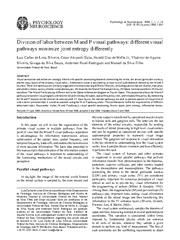A copy of this work was available on the public web and has been preserved in the Wayback Machine. The capture dates from 2017; you can also visit the original URL.
The file type is application/pdf.
Division of labor between M and P visual pathways: Different visual pathways minimize joint entropy differently
2008
Psychology and Neuroscience
Visual perception and action are strongly linked with parallel processing channels connecting the retina, the lateral geniculate nucleus, and the input layers of the primary visual cortex. Achromatic vision is provided by at least two of such channels formed by the M and P neurons. These cell pathways are similarly organized in primates having different lifestyles, including species that are diurnal, nocturnal, and which exhibit a variety of color vision phenotypes. We describe the M and P cell
doi:10.3922/j.psns.2008.1.002
fatcat:wgjuijn6zrhuzebkmshch7pfee

